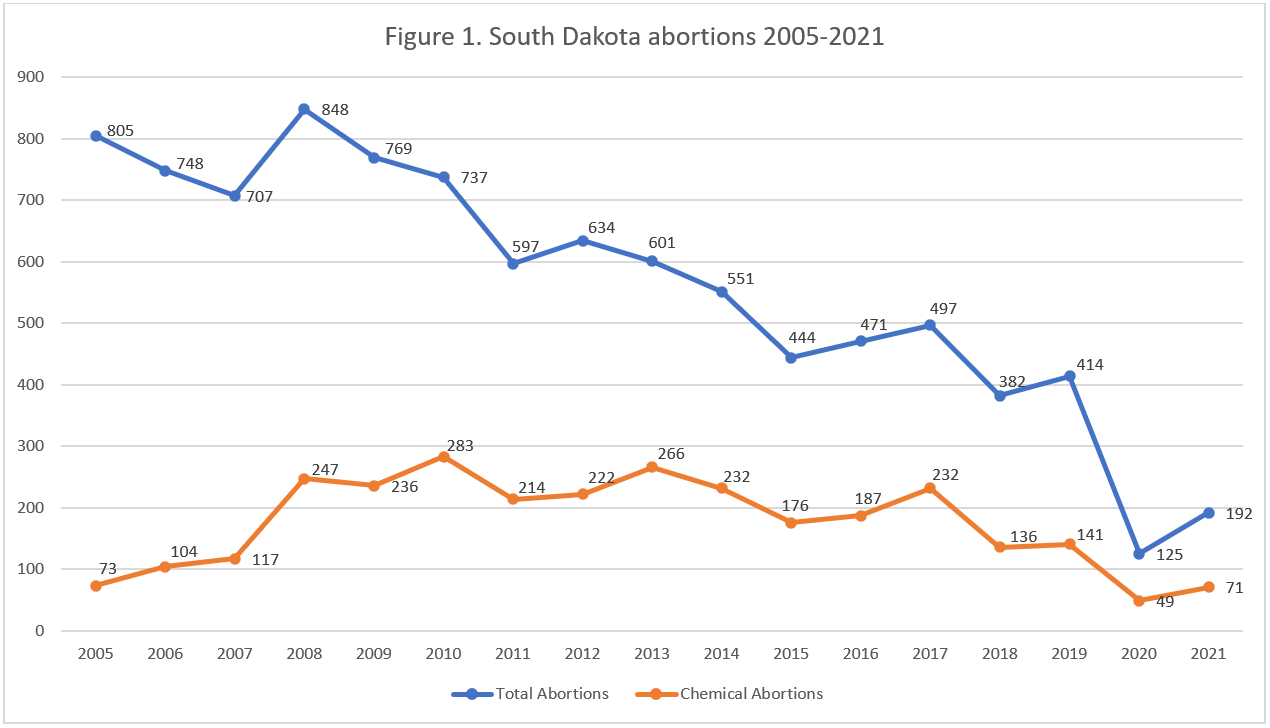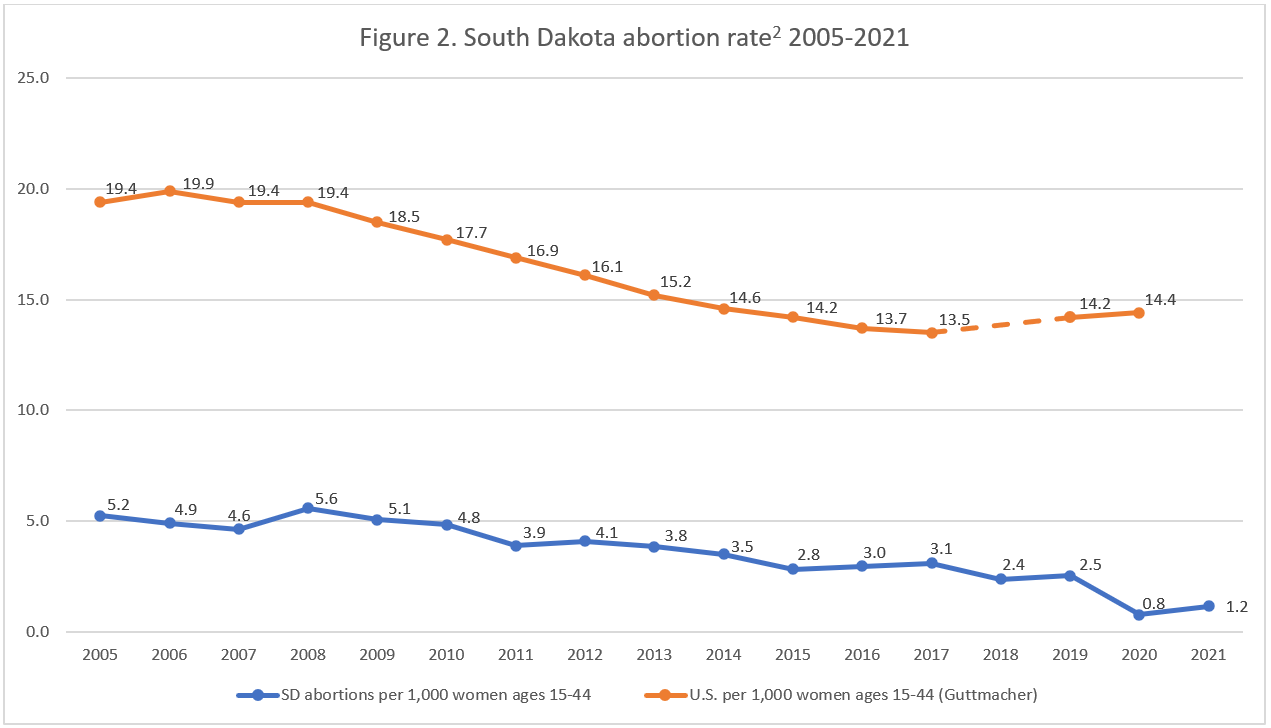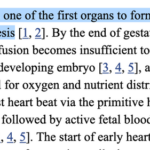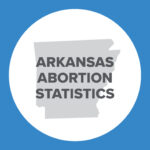Abortion Reporting: South Dakota (2021)
South Dakota’s 2021 abortion report was published by the South Dakota Department of Health in June 2022. The report shows that chemical abortion and abortions altogether sharply increased in 2021 from 2020. This is the fourth state summary from Charlotte Lozier Institute covering calendar year 2021 from states that publish annual reports.
The June 2022 report contains provisional data that is subject to change.
Statistics and Changes in South Dakota Abortions, 2020-2021

The report does not include information on Planned Parenthood’s South Dakota abortion market share.
Abortion Totals and Trends
There were 192 abortions reported in South Dakota in 2021, an increase of 54 percent from 2020 but still a 54 percent decrease from the number of abortions in 2019 (414) (Fig. 1). Chemical abortions increased by 45 percent, making up 37 percent of all abortions in the state. The Charlotte Lozier Institute (CLI) estimates that South Dakota’s abortion rate was 1.2 abortions per 1,000 women of childbearing age – an increase of 51 percent since 2020, yet still well below the national rate (Fig. 2). As of October 2022, 22 states have released 2021 abortion statistics, of which 15 showed that abortions had increased from 2020.
State Report Summary
In 2021, 91 percent of South Dakota abortions were performed on state residents. Five percent were performed on women from Minnesota, and four percent were obtained by women from Iowa. Thirty-one percent of the abortions were performed on women ages 20 to 24, while 28 percent were performed on women ages 25 to 29. An additional 30 percent were performed on women in their thirties or older. Twenty-one abortions were performed on girls under the age of 20 (11 percent), including six abortions on girls ages under 18. Parental notification was provided in advance of all six of the abortions performed on minors under age 18.
Fifty-three percent of the abortions reported in South Dakota (102) were performed on non-Hispanic white women. Thirteen percent (24 abortions) were on non-Hispanic black women, and 11 percent (22 abortions) were on non-Hispanic American Indian women. Five percent (9 abortions) were on non-Hispanic Asian women. Eight percent (15 abortions) were on Hispanic women. One percent (two abortions) were performed on women of multiple races. Race was not reported for 18 abortions.
Sixty-three percent of South Dakota abortions were performed on women with a high school education or less. Nineteen percent were on women who had completed some college and another 19 percent were on women with a college degree or another type of certificate. Eighty-seven percent of the abortions (167 abortions) were performed on unmarried women, and 13 percent (25 abortions) were on married women.
Nearly three-quarters of the abortions, 74 percent, were obtained by women who reported no prior abortions. Nineteen percent were on women with one previous abortion, and seven percent were performed on women with more than one prior abortion. Forty-one percent of South Dakota abortions were on women with two or more living children, while 31 percent were on women with zero living children, and 28 percent were on women with one living child. Nineteen percent of the abortions were performed on women who had previously had a miscarriage.
Sixty-two percent of the abortions reported in South Dakota in 2021 were suction abortions, and 37 percent were chemical. One percent were performed using other procedures that were not specified in the report. Fifteen percent of the abortions occurred at six weeks of gestation or earlier, and 25 percent were reported between seven and eight weeks. Thirty-five percent of South Dakota abortions were performed between nine and 10 weeks of gestation, 16 percent occurred between 11 and 12 weeks and 9 percent were performed at 13 weeks of gestation or later. There were no abortion-related complications reported in 2021.1
Eighty-three percent of the abortions were self-pay. Fourteen percent (27 abortions) were covered by private insurance, and three percent (five abortions) were covered by a public health plan, which South Dakota defines as “any plan established or maintained by a state, county, or other political subdivision of a state that provides health insurance coverage to enrolled individuals.” The majority of abortions (53 percent) cost between $600 and $699. Twenty-three percent cost less than $600, and another 23 percent cost $700 or more.
Thirty-seven percent of women undergoing abortions in South Dakota did not receive anesthesia. A local anesthetic was used for 62 percent of the abortions, and a general anesthetic was used for one percent. Thirty-four percent of the abortions were performed by OB-GYNs, and 66 percent were performed by doctors specializing in family medicine.
Six percent of the unborn babies killed by abortion weighed 50 grams or more, while two percent weighed less than 50 grams. Weight was not reported for 92 percent of the abortions. Two of the unborn babies had abnormalities; the report did not indicate the types of abnormalities the babies had. It was unknown whether the remaining 190 babies had abnormalities.
Sixty-two percent of the unborn babies’ bodies were incinerated, and 38 percent were disposed of as medical waste or discarded via unknown means.
In South Dakota, women’s reasons for choosing abortion are recorded, and women can give more than one reason. In 2021, 44 percent of the women undergoing abortions reported more than one reason. Sixty-nine percent of the abortions were performed because the woman did not desire to have the child, and 46 percent were performed because the woman could not afford the child. Twenty-three percent were performed for the woman’s emotional health, three percent were performed because of rape and incest, and another three percent were performed due to the risk of harm to a major bodily function. Seventeen percent of the abortions were performed for some other reason.
The South Dakota Department of Health received 222 informed consent forms in 2021. Of the 222 women, 192 went on to obtain abortions, and 30 did not.
The opportunity to view the ultrasound was offered to 221 women, of whom 116 accepted while 105 did not. The report doesn’t indicate how many of these women went on to have an abortion. Similarly, 221 forms indicated that the woman was offered the opportunity to listen to her baby’s heartbeat; 77 women accepted the opportunity.
2021 Legislative Changes
In 2021, South Dakota Governor Kristi Noem signed five pro-life measures into law. In February of 2021, Gov. Noem signed H1051 into law. This law strengthened South Dakota’s existing protections for babies born alive following a failed abortion and added an enforcement mechanism if the law is not followed. The law also amended South Dakota’s abortion reporting requirements to ensure that all babies who survive abortions are reported. The law took effect in July 2021. In March 2021, four additional pro-life measures were signed into law, two of which impact topics covered within this report and are explained below.
- H1110– This law protects unborn babies diagnosed with Down syndrome from discriminatory abortions and took effect in July of 2021.
- H1130– This law amended the state’s informed consent process to ensure that women undergoing chemical abortions are provided with resources on abortion pill reversal.
In June 2022, the U.S. Supreme Court decided Dobbs v. Jackson Women’s Health Organization, now allowing a South Dakota law limiting abortion to go into effect. South Dakota law now protects all unborn babies from abortion except in cases in which the life of the mother is at risk.
State Ranking
In 2016, CLI analyzed abortion reporting across the 50 states, New York City, and the District of Columbia. South Dakota’s reporting was tied for 7th best. South Dakota could further improve its reporting by requiring all healthcare professionals and facilities, including emergency rooms, to report abortion complications they encounter. South Dakota could also report the types of abnormalities that unborn babies had.


- Statistics on abortion complications reported here represent a minimal number of deaths and complications, as this data is collected in a non-systematic and non-verifiable way. As such, this data cannot be used to calculate either an accurate abortion mortality rate or an accurate abortion complication rate for the state.
- Rates were calculated by CLI using the following formula: (total number of abortions performed in South Dakota ÷ number of resident women ages 15-44) x 1,000. Rates may differ slightly from previous CLI articles due to revised population estimates. Population estimates were obtained from the CDC WONDER database. Estimates for 2005-2009 are intercensal estimates of the July 1 resident population. Estimates for 2010-2019 are Vintage 2020 postcensal estimates of the July 1 resident population. Estimates for 2020-2021 are Vintage 2021 postcensal estimates of the July 1 resident population. Estimates were produced by the U.S. Census Bureau and the National Center for Health Statistics.

























